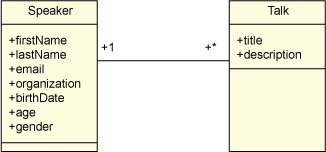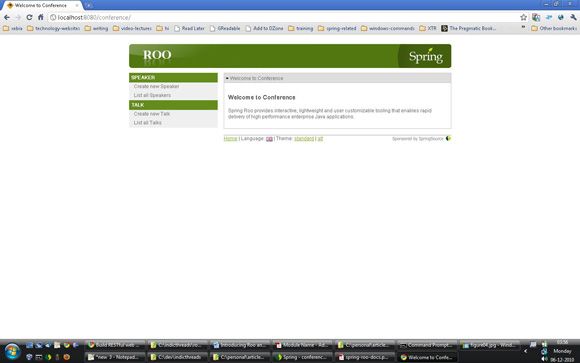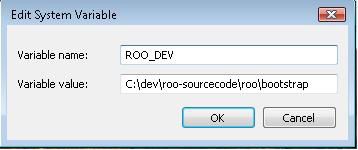Spring Roo 简介,第 1 部分: 从源代码构建
简介: Spring Roo 是针对 Java™ 技术的一个轻量级生产力工具,可快速便捷地开发基于 Spring 的应用程序。使用 Spring Roo 创建的应用程序遵循 Spring 最佳实践,且基于 JPA、Bean Validation (JSR-303) 和 Dependency Injection (JSR-330) 等标准。Roo 提供一个使用方便、上下文感知、由标签完成的 shell 构建应用程序。Spring Roo 可扩展且支持附件,进一步增强了其功能。本文介绍 Spring Roo 并提供在 Windows® 和 *nix 系统上编译 Spring Roo 源代码的分布指导。
简介
Spring 框架于 2002 年年底发布,目的在于简化 J2EE(目前是 JavaEE)开发。在过去 8 年中,Spring 成功完成了该使命,提供了 Java 社区框架或功能,比如 Spring Security、Spring MVC、事务管理、Spring 批处理和 Spring 集成,这都易于理解和使用。Spring 希望让 Java 开发人员的工作更轻松、更富成效。为此,Spring 创建了一个名为 Spring Roo 的开发工具。
Spring Roo(参见 参考资料)是针对 Java 技术的一个可扩展的、基于文本的开源 RAD 工具。它是用于创建和管理基于 Spring 的应用程序的一个强大资源。这里是任务说明:
Roo 的任务是从根本上可持续地改善 Java 开发人员的生产效率,而无损工程完整性和灵活性。
这一要求转换为构建于 Java 技术之上的一种工具,可持续地增加项目整个生命周期的生产效率,且不限定开发人员使用某一特定方法。Spring Roo 使用流行、可靠和成熟的库,比如 Spring 框架、Java 持久化 API、Java Server Pages (JSP)、Spring Security、Spring Web Flow、Log4J 和 Maven。Roo 生成的应用程序使用 Bean Validation (JSR-303) 和 Dependency Injection (JSR-330) 这样的标准,且遵循最佳实践 SpringSource 认证的应用程序架构。
使用 Spring Roo,您可以添加和配置 JPA、Spring MVC、Spring Security 等功能,使用 Log4j 进行日志记录,测试 JUnit 和 Selenium、Solr、JMS、电子邮件等框架,仅需在 Roo shell 上输入命令即可。使用 Roo 添加这些功能节省的时间提高了开发人员的生产效率。Roo 不能编写业务逻辑,但可以管理应用程序的基础结构或配置。
Roo 是一个开发时间工具,这意味着应用程序在运行时独立于 Roo。由于 Roo 在运行时不存在,它没有任何性能或内存开销。这确保您不依赖于 Spring Roo,您只需几个按键即可随时从您的项目中删除 Roo。
本文讨论如何使用 Roo shell 构建简单的 web 应用程序,并展示如何在 Windows 或 Ubuntu 机器上编译 Spring Roo 源代码。
开始使用 Roo shell
通过加载 Roo shell 并使用命令与之交互,您可以管理和配置应用程序。Roo Shell 是一个制表完成的、上下文感知的、提供提示的命令 shell。您可以使用 hint 命令询问 Spring Roo 您的下一步逻辑操作。Roo 足够智能,可通过判定应用程序上下文建议下一步行动。例如,比方说您使用 entity 命令创建了一个实体。然后输入 hint 命令。Roo 会告诉您应当使用 field 将字段添加到您的实体。该特性减少了 Roo 的概念权重,使其成为一个优秀的学习工具。您可以跟随 Roo help 和 hint 命令创建完全的应用程序,无需参考文档。
先决条件
在开始使用 Roo 之前,确保您安装了:
- Java V6 JDK
- Apache Maven V2.0.9 或更高
安装 Spring Roo
要安装独立的 Spring Roo:
- 您可以下载 Roo 独立命令行 shell 或使用内置的 Roo SpringSource Tool Suite (STS) 插件。我建议两者都下载并一起使用,因为 STS 为基于 Spring 的应用程序通过 Eclipse 提供许多额外功能。
- Spring Roo
- SpringSource Tool Suite
- 解压 Spring Roo 到选定位置。
- 设置环境变量:
- 在一台 Windows 机器上,添加 %ROO_HOME% /bin 到这样的路径:其中 ROO_HOME 是解压的 Roo 文件的路径。
- 在一台 *nix 机器上,创建到 $ROO_HOME/bin/roo.sh 的一个符号链接
(例如,sudo ln -s ~/spring-roo-1.x.x/bin/roo.sh /usr/bin/roo)
构建应用程序
为向您展示 Roo 的强大功能,让我们创建一个简单的企业会议应用程序。一个会议应用程序有两个实体:Speaker 和 Talk。一个 Speaker 可以提供一次或多次讲话,且 Talk 将仅由一个发言人提供。简单的类图如图 1 所示。
图 1. 类图 Speaker Talk

创建应用程序:
- 打开操作系统命令行 shell。
- 使用 mkdir 命令创建一个名为 conference 的目录。
- 转到您的 shell 中的 conference 目录。
- 输入 roo。该命令将启动 Roo shell,如清单 1 所示。
清单 1. 启动 Roo shell
C:\Users\xebia\demo\conference>roo
____ ____ ____
/ __ \/ __ \/ __ \
/ /_/ / / / / / / /
/ _, _/ /_/ / /_/ /
/_/ |_|\____/\____/ 1.1.B.RELEASE [rev 793f2b0]
Welcome to Spring Roo. For assistance press TAB or type "hint" then hit ENTER.
roo> |
既然我们在 Roo shell 内部,我们将使用 Roo 的 hint 命令来引导接下来的步骤。hint 建议使用 project 创建一个新的基于 Maven 的 Spring 项目(参见清单 2)。
清单 2. 使用 Roo shell 中的 hint
Welcome to Spring Roo. For assistance press TAB or type "hint" then hit ENTER. roo> hint Welcome to Roo! We hope you enjoy your stay! Before you can use many features of Roo, you need to start a new project. To do this, type ’project’ (without the quotes) and then hit TAB. Enter a --topLevelPackage like ’com.mycompany.projectname’ (no quotes). When you're finished completing your --topLevelPackage, press ENTER. Your new project will then be created in the current working directory. Note that Roo frequently allows the use of TAB, so press TAB regularly. Once your project is created, type ’hint’ and ENTER for the next suggestion. You're also welcome to visit http://forum.springframework.org`for Roo help. roo> |
正如 hint 命令所建议的,我们将使用 project 命令创建一个项目。该命令有一个必要属性 topLevelPackage,用于指定根程序包的名称。除了必要属性之外,我们将使用两个可选属性:java(指定 Java 版本)和 projectName(指定项目名称)。输入以下内容:
project --topLevelPackage com.dw.roo.conference --java 6 --projectName conference |
该命令将创建一个 Maven V2 管理的基于 Spring 的项目,如以下输出所示:
Created C:\Users\xebia\demo\conference\pom.xml Created SRC_MAIN_JAVA Created SRC_MAIN_RESOURCES Created SRC_TEST_JAVA Created SRC_TEST_RESOURCES Created SRC_MAIN_WEBAPP Created SRC_MAIN_RESOURCES\META-INF\spring Created SRC_MAIN_RESOURCES\META-INF\spring\applicationContext.xml Created SRC_MAIN_RESOURCES\log4j.properties |
再次输入 hint 向 Roo 询问下一步行动。这次它建议建立持久化机制。在 shell 上输入 persistence setup 并按下 Tab 三次。您会获得 --provider 选项。按下 H 然后按下 Tab 完成 “HIBERNATE”。在提供者之后,按下 tab 选择数据库,您会看到有大量选项。因为我们使用 Hibernate 作为我们的提供者,我们不能选择非关系型数据库,比如 Google App Engine。现在,我打算使用 HYPERSONIC_IN_MEMORY 数据库。
persistence setup --provider HIBERNATE --database HYPERSONIC_IN_MEMORY |
还有其他可选属性,比如用户名和密码,这次我们不需要这些。
现在我们已经建立了持久化机制,我们将再次使用 hint 命令。这次我们被告知要使用 entity 命令创建实体。Entity 用于创建实际域对象,且有一个必要属性 class,用于指定实体的名称。除了必需的 --class 属性,我们还将使用 --testAutomatically 属性,该属性为域对象创建集成测试。让我们创建两个实体:Speaker 和 Talk。
entity --class ~.domain.Speaker –testAutomatically entity --class ~.domain.Talk --testAutomatically |
我使用了 ~ 作为项目顶级程序包的占位符。
Entity 将创建一个灵活的、特性丰富的 JPA 实体。所创建的实体将有 JPA @Entity ,带有 ID、版本、EntityManager 和无参数的构造函数。所生成的实体将拥有 persist、merge、remove、flush、count、find 和 findById 等方法。如果看一下该命令的输出,您会注意到该命令除了创建 Java 文件(为 Speaker 和 Talk),还创建了以 *Roo_*.aj 结尾的 AspectJ 文件。这些 *Roo_*.aj 称为 Intertype Declaration (ITD)、Mixins 或 Introductions。Roo 将 ITD 作为一个代码生成的工件。ITDs 允许 Roo 在一个单独的编译单元中生成代码,但 ITDs 在编译时被合并成同一个编译类。AspectJ intertype 声明用于自动生成 ID 和版本字段,以及域类中持久化字段的 getters 和 setters。
再次使用 hint 提供建议,根据建议使用 field 命令将字段添加到实体。让我们给 Speaker 实体添加一些字段:
field string --fieldName firstname --class ~.domain.Speaker --notNull field string --fieldName lastname --notNull field string --fieldName email --unique --notNull field string --fieldName organization field date --fieldName birthdate --type java.util.Date --past --notNull field number --type java.lang.Long --fieldName age --min 25 --max 60 |
--class 选项允许我们指定向哪个类添加字段。
field 命令可用于指定特定于 JavaBean 验证的注释,含有 --max 和 --min 等选项。它还可用于指定特定于 JPA 的注释,含有 --fetch、--column 和 --unique 等选项。对于日期字段,您还可以指定日期应当是过去还是将来,正如上面使用的。使用 field,您无需记住这些注释。
现在让我们向 Talk 实体添加一些字段:
field string --fieldName title --class ~.domain.Talk --notNull field string --fieldName description --notNull --sizeMax 4000 |
目前为止,我们创建了实体并向其添加了字段,但是我们没有指定它们之间的关系。Speaker 与 Talk 之间的关系是 ONE_TO_MANY(例如,一个发言人可发表多次讲话)。这通过 field 完成,如下所示:
field set --fieldName talks --element ~.domain.Talk --class \ ~.domain.Speaker --cardinality ONE_TO_MANY field reference --fieldName speaker --type ~.domain.Speaker \ --class ~.domain.Talk –notNull |
现在我们想为会议应用程序 scaffold(搭建) 一个 web 层,可通过 controller 命令完成。生成控制器和所有相关 web 工件最方便的方式是使用 controller all。
controller all --package ~.web |
第一次使用控制器命令还会添加额外的依赖项到您的项目中,比如 Spring MVC 和 Tiles。这可能需要一些时间来运行,因为它需要下载所有依赖项(如果它们不存在于您的 Maven 存储库中)。该命令还展示 Roo 的功能之一:只有在需要依赖项时才予以添加。
下一步,我们将使用 logging 命令建立 log4j。
logging setup --level INFO --package ALL_SPRING |
退出 Roo shell 之前应做的最后一件事是,当我们使用 entity 命令指定了 --testAutomatically 时,运行生成的集成测试。要从 shell 中运行测试,输入 perform tests。
Roo 将调用委托给 Maven 来运行测试,因此 perform tests 等同于 mvn test 命令。输入 q 或 quit 退出 shell。
这些命令将创建一个功能齐全的会议应用程序。接下来我们将运行这个应用程序。
要运行该应用程序,输入 mvn tomcat:run,这将启动 jetty 服务器。打开 web 浏览器并转至 http://localhost:8080/conference/。您会看到图 2 中的屏幕。
图 2. 会议应用程序主页

您可以单击 Create new Speaker 创建一个会议发言人。您还可以单击 List all Speakers 来查看、编辑和删除用户。以同样的方式,您可以创建一个 Talk,但是必须在创建 Speaker 之后。
这是一个简单的应用程序,但是它展示如何在数分钟内从头轻松创建一个新的基于 Spring 的 web 应用程序。在本系列的第 2 部分,我将向您展示如何使用不同的 Roo 功能和附加组件构建应用程序。
现在我们已经创建了一个简单的应用程序,我将向您展示如何在 Windows 和 Ubuntu 上编译 Spring Roo 源代码。
从源代码构建 Spring Roo
Spring Roo V1.1.0 是最新发布版本,目前正在积极开发 V1.1.1 版本。您可能需要从源代码构建 Spring Roo 的原因如下:
- Spring Roo 不提供夜间构建,因此如果您希望使用 Spring Roo 的最新功能,就需要编译 Spring Roo 的源代码。
- 您希望为 Spring Roo 项目做任何类型的开发。
- 您希望为 Spring Roo 编写附加组件。
- 您只希望把玩一下 Spring Roo 代码,看看它是如何实现或编写的。
结果
在本部分结尾,您将能够在 Windows 和 *nix 系统上成功运行最新 Spring Roo 源代码的 Maven 版本。您将能够使用最新的 Spring Roo 并将 Spring Roo 项目导入 Eclipse 或 STS (SpringSource Tool Suite)。
在 Ubuntu 上编译 Spring Roo 源代码的过程
在 Ubuntu(和其他 *nix 系统)上编译源代码很容易。只需遵循以下步骤:
- 安装 Git,一个分布式源代码控制管理系统。要在 Ubuntu 系统上安装它,输入 sudo apt-get install git-core gitk。
- 输入 git clone git://git.springsource.org/roo/roo.git,使用 Git 签出 Spring Roo。您将在主目录中看到一个 roo 文件夹,其中包含所有 Roo 源代码。
- GnuPG 支持数据和通信的加密和签名,且以一个多功能的密钥管理系统和各种公钥目录的访问模块为特色。Roo 使用 GPG 来自动签名编译输出。
- 触发命令 gpg --list-secret-keys。输出应当类似于清单 3。
清单 3. gpg list 命令的结果
C:\dev\roo-sourcecode\roo>gpg --1ist-secret-keys C:/Users/xebia/AppData/Roaming/gnupg\secring.gpg sec 2048R/2F96093B 2010-07-03 uid shekhar (spring-roo) <[email protected]> ssb 2048R/B77E5C63 2010-07-03 C:\dev\roo-sourcecode\roo>_
- 如果您看不到输出,首先必须创建一个密钥。使用 gpg –gen-key,它将引导您逐步创建密钥。然后使用 gpg –list-secret-keys 验证您新创建的密钥已生成。
- 接下来,您需要发布您的密钥到公钥服务器。注意 –list-secret-keys 中显示的 sec 密钥 ID。在我的例子中,密钥 ID 是 2F96093B。通过 gpg –keyserver hkp://pgp.mit.edu –send-keys 2F96093B 将您的公钥推送到一个密钥服务器(在结尾更改密钥 ID)。
- 一些 Roo 模块需要已经不以 OSGi 形式存在的 JAR。即,它们没有一个 OSGi 感知的清单。Roo 有一个称为 wrapping 的特殊项目,可将常态 JAR 转化为 OSGi JAR。您需要在试图使用 Roo 之前运行包装程序。没有包装程序,您将看到错误,说 Maven 无法找到 org.springframework.roo.wrapping.some_module。要创建 JAR 文件包,从根 Roo 签出位置输入:
cd wrapping mvn clean install cd..
- 接下来,运行 mvn clean install 命令。(Maven V2 应当安装在了您的系统上。如果没有,立即安装它。)每次编译源代码时,Maven 将提示您输入您的密钥的密码/口令(您输入了口令的同时创建 GPG 密钥)。输入口令并按下 Enter。编译源代码需要几分钟时间。
在 Windows 上编译 Roo 源代码的过程
与 Ubuntu 相比,在 Windows 上编译源代码有点困难。请遵循以下步骤:
- 安装 Git,一个分布式源代码控制管理系统。要开始此过程,您需要在您的 windows 机器上安装 Git。我在我的 windows 机器上安装了 msysGit 。如果您已经安装了 Git,那么可以跳过这一步。在安装 msysGit 时,它会要求选择安装位置。它会打开一个命令提示符,并开始触发大量命令。这将持续大约 1 分钟。安装完成之后,您将看到如清单 4 所示的一个屏幕。
清单 4. 安装 msysGit
{ test "$bindir/" = "$execdir/" || \ { rm -f "$execdir/git.exe" && \ test -z "" && \ ln "$bindir/git.exe" "$execdir/git.exe" 2>/dev/null || \ cp "$bindir/git.exe" "$execdir/git.exe"; } ; } && \ { for p in git-add.exe git-annotate.exe git-apply.exe git-archive.exe git-bisect--helper.exe git-blame.exe git-branch.exe git-bundle.exe git-cat-file.exe git-check-attr.exe git-check-ref rm -f "$execdirf$p" && \ ln "Sexecdir/git.exe" "Sexecdir/$p" 2>/dev/null ll \ ln -s "git.exe" "$execdir/$p" 2>/dev/null || \ cp "Sexecdir/git.exe" "$execdir/$p" Il exit; \ done; } && \ { test x"git-renote-https.exe git-renote-ftp.exe \ git-renote-ftps.exe" = x ll \ { for p in git-remote-https.exe git-remote-ftp.exe \ git-remote-ftps.exe; do \ rm -f "$execdir{$p" && \ ln "Sexecdir/git-remote-http.exe" "$execdir/$p" 2>/dev/null ll \ ln -s “git-renote—http.exe" "$execdir/$p" 2>/dev/null || \ cp "Sexecdir/git-remote-http.exe" "Sexecdir/$p" ll exit; \ done; } ; } && \ ./check_bindir "z$bindir" "z$execdir" "Sbindir/git—add.exe" ------------------------- Hello, dear Git developer. This is a minimal MSYS environment to work on Git. You are in the git working tree, and all is ready for you to hack. Welcome to msysGit Run 'git help git' to display the help index. Run 'git help <command>' to display help for specific commands. Run '/share/msysGit/add-shortcut.tcl' to add a shortcut to msysGit. It appears that you installed msysGit using the full installer. To set up the Git repositories, please run /share/msysGit/initialize.sh
- 设置 Git 环境变量。需要在您的 Windows 路径中设置 Git。将 ${MSYSGIT}\msysgit\bin 和 {MSYSGIT}\msysgit\mingw\bin 添加到您的 Windows 路径中,其中 ${MSYSGIT} 是安装 msysGit 的位置。打开一个新的命令提示符并输入 git。您将看到如图 7 所示的输出。
清单 5. Git 命令提示符
C:\>git usage: git [--version] [--exec-path[=GIT_EXEC_PATH]] [--html-path] [-pl--paginate|I--no-pager] [--no-replace-objects] [--bare] [--git-dir=GIT_DIR] [--work-tree=GIT_WORK_TREE] [-c name=value [--help] COMMAND [ARGS] The most commonly used git commands are: add Add file contents to the index bisect Find by binary search the change that introduced a bug branch List, create, or delete branches checkout Checkout a branch or paths to the working tree clone Clone a repository into a new directory commit Record changes to the repository diff Show changes between commits, commit and working tree, etc fetch Download objects and refs from another repository grep Print lines matching a pattern init Create an empty git repository or reinitialize an existing log Show commit logs merge Join two or more development histories together mv Move or rename a file, a directory, or a symlink pull Fetch from and merge with another repository or a local bra push Update remote refs along with associated objects rebase Forward-port local commits to the updated upstream head reset Reset current HEAD to the specified state rm Remove files from the working tree and from the index show Show various types of objects status Show the working tree status tag Create, list, delete or verify a tag object signed with GPG See ’git help COMMAND’ for more information on a specific command. C:\>_
- 使用 Git 签出 Spring Roo。在这一步中,您将使用 Git 签出最新源代码,从而创建 Spring Roo 的本地克隆。打开一个命令提示符并转至您希望签出 Spring Roo 的位置。输入 git clone git://git.springsource.org/roo/roo.git 。一直等到它完成为止。这将在您签出 Spring Roo 的位置创建一个名为 roo 的新文件夹。
- 下载和安装 GPG for Windows。GnuPG 是 GNU 用于确保安全通信和数据存储的工具。它可用于加密数据和创建数字签名。Roo 使用 GPG 来自动签名编译输出。安装了 GPG 之后,使用 gpg –list-secret-keys。您应当会看到类似清单 6 的输出。
清单 6. gpg list 命令的结果
C:\dev\roo-sourcecode\roo>gpg --1ist-secret-keys C:/Users/xebia/AppData/Roaming/gnupg\secring.gpg sec 2048R/2F96093B 2010-07-03 uid shekhar (spring-roo) <[email protected]> ssb 2048R/B77E5C63 2010-07-03 C:\dev\roo-sourcecode\roo>_
- 如果没有看到输出,这表明您首先需要创建一个密钥。使用 gpg –gen-key。它会引导您逐步创建密钥。使用 gpg –list-secret-keys 验证您新创建的密钥已生成。
- 发布您的密钥到一个公钥服务器上。注意 –list-secret-keys 上显示的 sec 密钥 ID。在我的例子中,该 ID 是 2F96093B。通过 gpg –keyserver hkp://pgp.mit.edu –send-keys 2F96093B 将您的公钥推送到一个密钥服务器上(在结尾更改密钥 ID)。
- 首先构建包装程序项目。一些 Roo 模块需要已经不以 OSGi 形式存在的 JAR。即,它们没有一个 OSGi 感知的清单。Roo 有一个名为 wrapping 的特殊项目,可将常态 JAR 转化成 OSGi JAR。您需要在试图使用 Roo 之前运行包装程序。没有安装程序,您将看到错误,说 Maven 无法找到 org.springframework.roo.wrapping.some_module。要创建 JAR 文件包,从根 Roo 签出位置输入:
cd wrapping mvn clean install cd..
- 运行 mvn clean install 命令。(Maven V2 应当安装在了您的系统上。如果没有,立即安装它。)每次编译源代码时,Maven 将提示您输入您的密钥的密码/口令(您输入了口令的同时创建 GPG 密钥)。输入口令并按下 Enter。编译源代码需要几分钟时间。
- 在您的系统设置中建立环境变量 ROO-DEV,该变量应指向 Roo 项目内的引导文件夹。您还应当添加该变量到 PATH 环境变量,如图 3 所示。
图 3. 建立 ROO-DEV 变量

您现在可以使用最新开发的 Roo 版本了。打开命令提示符,创建一个名为 mkdir roo_dev_demo 的新文件夹,并触发 roo-dev 命令。您将看到清单 7 中所示的屏幕。
清单 7. ROO-DEV shell
C:\Users\xebia\demo\conference>roo
____ ____ ____
/ __ \/ __ \/ __ \
/ /_/ / / / / / / /
/ _, _/ /_/ / /_/ /
/_/ |_|\____/\____/ 1.1.B.RELEASE [rev 793f2b0]
Welcome to Spring Roo. For assistance press TAB or type "hint" then hit ENTER.
roo> |
您可能希望更新 Spring Roo 源代码来使用最新版本的 Spring Roo。打开命令提示符并转至 Spring Roo 的源代码位置。触发 git pull 命令,该命令会将所有远程更改拉入到您的本地克隆中,然后执行一个 mvn clean install 命令来编译更新的源代码。
结束语
此时,您已经构建了一个简单的 web 应用程序,期间甚至无需打开我们的编辑器或参考任何文档。应用程序允许您对实体执行 CRUD 操作。我希望您看到 Roo 为 Java 开发人员带来了重大生产效率收益。它使用大部分开发人员已经熟知的成熟和稳定的技术。
在第 2 部分,我们将使应用程序更安全、添加国际化支持、添加消息传递支持(SMTP 和 JMS),并定制应用程序。我们还将探究 Roo 的一个数据库逆向工程特性,将该应用程序转化为一个功能全面的企业应用程序。
参考资料
学习
- 更多了解 Spring Roo。
- 查看 Spring Roo 源码。
- 熟读 developerWorks Java 技术专区,这里有数百篇关于 Java 编程各个方面的文章。
- 要收听面向软件开发人员的有趣访谈和讨论,请查看 developerWorks 播客。
- 随时关注 developerWorks 的 技术活动 和 网络广播。
- 查阅最近将在全球举办的面向 IBM 开放源码开发人员的研讨会、交易展览、网络广播和其他 活动。
- 访问 developerWorks Open source 专区,获得丰富的 how-to 信息、工具和项目更新,帮助您用开放源码技术进行开发,并与 IBM 产品结合使用,以及我们 最受欢迎的文章和教程。
- 查看免费的 developerWorks 演示中心,观看并了解 IBM 及开源技术和产品功能。
获得产品和技术
- 使用 IBM 产品评估试用版软件 改进您的下一个开发项目,这些软件可以通过下载或从 DVD 获得。
- 下载 IBM 产品评估试用版软件 或 IBM SOA Sandbox for People,并开始使用来自 DB2®、Lotus®、Rational®、Tivoli® 和 WebSphere® 的应用程序开发工具和中间件产品。
讨论
- 参与 developerWorks 博客 并加入 developerWorks 社区。
- 加入 developerWorks 中文社区。查看开发人员推动的博客、论坛、组和 wikis,并与其他 developerWorks 用户交流。
关于作者
Shekhar Gulati 是 Xebia India 的一名 Java 顾问。他用 Java 编程语言开发软件已经 5 年有余。他在 http://whyjava.wordpress.com 上写了个人博客。